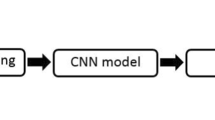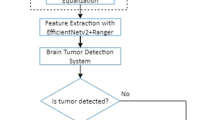Abstract
From the past decade, many researchers are focused on the brain tumor detection mechanism using magnetic resonance images. The traditional approaches follow the feature extraction process from bottom layer in the network. This scenario is not suitable to the medical images. To address this issue, the proposed model employed Inception-v3 convolution neural network model which is a deep learning mechanism. This model extracts the multi-level features and classifies them to find the early detection of brain tumor. The proposed model uses the deep learning approach and hyper parameters. These parameters are optimized using the Adam Optimizer and loss function. The loss function helps the machines to model the algorithm with input data. The softmax classifier is used in the proposed model to classify the images in to multiple classes. It is observed that the accuracy of the Inception-v3 algorithm is recorded as 99.34% in training data and 89% accuracy at validation data.









Similar content being viewed by others
References
Cheng J, Brain Tumor Dataset. Figshare. Dataset. Accessed: Sep. 19, 2020. [Online]. Available: https://doi.org/10.6084/m9.gshare.1512427.v5.
Abiwinanda N, Hanif M, Hesaputra ST, Handayani A, Mengko TR (2019) Brain tumor classication using convolutional neural network. In: Proceedings of World Congress of Medical Physics and Biomedical Engineering. Springer, Singapore, pp 183–189
Afshar P, Mohammadi A, Plataniotis KN (2018) Brain tumor type classification via capsule networks. In: Proceedings of the 25th IEEE International Conference on Image Process (ICIP), pp 3129–3133
Brain Tumor Statistics, American Brain Tumor Association. Accessed: Mar. 17, 2020. [Online]. Available: http://abta.pub30.convio.net/
Banerjee S, Mitra S, Masulli F, Rovetta S (2019) Deep radiomics for brain tumor detection and classification from multi-sequence MRI. arXiv:1903.09240
Charron O, Lallement A, Jarnet D, Noblet V, Clavier JB, Meyer P (2018) Automatic detection and segmentation of brain metastases on multimodal MR images with a deep convolutional neural network. Comput Biol Med 95:43–54
Deepak S, Ameer PM (2019) Brain tumor classi cation using deep CNN features via transfer learning. Comput Biol Med 111:103345
Gu Y, Lu X, Yang L, Zhang B, Yu D, Zhao Y, Zhou T (2018) Automatic lung nodule detection using a 3D deep convolutional neural network combined with a multi-scale prediction strategy in chest CTs. Comput Biol Med 103:220–231
Ismael MR, Abdel-Qader I (2018) Brain tumor classication via statistical features and back-propagation neural network. In: Proceedings of the IEEE International Conference on Electronics/Information Technology (EIT), pp 0252–0257
Jayalakshmi M, Nagaraja Rao S (2020) Discrete wavelet transmission and modified PSO with ACO based feed forward neural network model for brain tumour detection. CMC Comput Mater Continua 65(2):1081–1096
Ji Q, Huang J, He W, Sun Y (2019) Optimized deep convolutional neural networks for identification of macular diseases from optical coherence tomography images. Algorithms 12(3):51
Kabir Anaraki A, Ayati M, Kazemi F (2019) Magnetic resonance imaging based brain tumor grades classication and grading via convolutional neural networks and genetic algorithms. Biocybern Biomed Eng 39(1):63–74
Kingma DP, Ba J, A method for stochastic optimization, arXiv: 1412.6980
Li X, Du Z, Huang Y, Tan Z (2021) A deep translation (GAN) based change detection network for optical and SAR remote sensing images. ISPRS J Photogramm Remote Sens 179:14–34
Mannor S, Peleg D, Rubinstein R (2005) The cross entropy method for classification. In: Proceedings of the 22nd international conference on Machine learning
Muneer KVA, Rajendran VR, Paul JK (2019) Glioma tumor grade identification using artificial intelligent techniques. J Med Syst 43(5):113
Nair V, Hinton G (2010) Rectified linear units improve restricted boltzmann machines, ICML
Naseer A, Rani M, Naz S, Razzak MI, Imran M, Xu G (2019) Re_ning Parkinson’s neurological disorder identi_cation through deep transfer learning. Neural Comput Appl 32:839–854. https://doi.org/10.1007/s00521-019-04069-0
Pashaei A, Sajedi H, Jazayeri N (2018) Brain tumor classification via convolutional neural network and extreme learning machines. In: Proceedings of the 8th International Conference on Computing Knowledge Engineering (ICCKE), pp 314–319
Razzak M (2019) Efficient brain tumor segmentation with multiscale Two-Pathway-Group conventional neural networks. IEEE J Biomed Health Informat 23(5):1911–1919
Rehman A, Naz S, Razzak MI, Akram F, Imran M (2019) A deep learning-based framework for automatic brain tumors classication using transfer learning. Circuits Syst Signal Process 39(2):757–775
Robbins H, Munro S (1951) A stochastic approximation method. Ann Math Stat 22:400–407
Sajjad M, Khan S, Muhammad K, Wu W, Ullah A, Baik SW (2019) Multi-grade brain tumor classication using deep CNN with extensive data augmentation. J Comput Sci 30:174–182
Siegel RL, Miller KD, Jemal A (2015) Cancer statistics. Cancer J Clin 65(1):5–29
Siegel R, Miller CR, Jamal A (2017) Cancer statistics. Cancer J Clin 67(1):7–30
Simonyan K, Zisserman A, Very deep convolutional networks for large-scale image recognition, arXiv: 1409.1556.
Somasundaram S, Gobinath R (2019) Current trends on deep learning models for brain tumor segmentation and detection–a review. In: 2019 International conference on machine learning, big data, cloud and parallel computing (COMITCon), IEEE, pp 217–221
Szegedy C, Liu W, Jia Y, Sermanet P, Reed S, Anguelov D et al. (2015) Going deeper with convolutions. In: Proceedings of the IEEE conference on computer vision and pattern recognition
Youse M, Krzy»ak A, Suen CY (2018) Mass detection in digital breast tomosynthesis data using convolutional neural networks and multiple instance learning. Comput Biol Med 96:283–293
Zuo H, Fan H, Blasch E, Ling H (2017) Combining convolutional and recurrent neural networks for human skin detection. IEEE Signal Process Lett 24(3):289–293
Funding
No funding.
Author information
Authors and Affiliations
Contributions
All authors have equally contributed, and all authors have read and agreed to the published version of manuscript.
Corresponding author
Ethics declarations
Conflict of interest
All authors declare that they have no conflict of interest.
Ethical approval
This article does not contain any studies with human participants or animals performed by any of the authors.
Additional information
Publisher's Note
Springer Nature remains neutral with regard to jurisdictional claims in published maps and institutional affiliations.
Rights and permissions
About this article
Cite this article
Lakshmi, M.J., Nagaraja Rao, S. Brain tumor magnetic resonance image classification: a deep learning approach. Soft Comput 26, 6245–6253 (2022). https://doi.org/10.1007/s00500-022-07163-z
Accepted:
Published:
Issue Date:
DOI: https://doi.org/10.1007/s00500-022-07163-z




